Introduction:
Camping with children creates lasting memories, but mealtime can quickly become stressful without proper planning. As an avid family camper, I’ve experienced firsthand how the right easy camping meals for kids can make or break your outdoor adventure. In 2025, with more families hitting the trails than ever before, having a repertoire of simple, nutritious, and kid-approved camping recipes is essential.
According to the Outdoor Industry Association, family camping has increased by 32% in the last three years! Whether you’re a camping novice or a seasoned outdoors family, these meal ideas will keep hungry young adventurers happy while minimizing your campsite cooking stress.
Planning Makes Perfect: Meal Prep Strategies
When I first started camping with my kids, I made the rookie mistake of thinking I could “figure out” meals at the campsite. One rainy afternoon with three hungry children later, I learned that proper planning is absolutely essential.
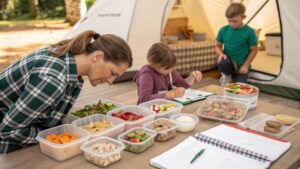
Before any camping trip, I now spend time creating a comprehensive meal plan that accounts for every breakfast, lunch, dinner, and snack. I consider factors like:
- How long we’ll be camping
- Available cooking equipment
- Perishable vs. shelf-stable ingredients
- Prep time required
- Kid preferences and dietary restrictions
I’ve found that prepping as much as possible at home makes campsite cooking infinitely easier. Chopping vegetables, marinating proteins, and pre-measuring ingredients can save valuable time and frustration when you’re cooking outdoors with limited space and facilities.
My must-have tool is a set of labeled, reusable containers organized by meal. This system has saved countless headaches, especially when we arrive at our campsite later than expected and need to quickly prepare dinner before darkness falls.
Breakfast Champions: Morning Meals That Fuel Adventure
Mornings at our campsite used to be chaotic until I discovered a few breakfast options that are both easy to prepare and substantial enough to fuel a day of exploration.
Campfire Breakfast Burritos
These have become our go-to first morning breakfast. I prep everything at home:
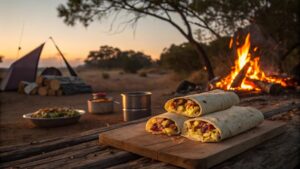
- Scramble eggs with a bit of milk and cook them about 80% done
- Cook and crumble breakfast sausage or bacon
- Grate cheese
- Chop bell peppers and onions (optional)
- Assemble burritos with the ingredients
- Wrap tightly in foil and freeze
At the campsite, I simply place the foil-wrapped burritos on the grill grate over the morning campfire or on a camp stove in a skillet. They heat through in about 15 minutes, providing a protein-packed start with minimal cleanup.
My youngest, who normally rejects eggs at home, devours these at the campsite. There’s something about eating outdoors that makes picky eaters more adventurous!
Make-Ahead Pancake Mix
Pancakes are incredibly versatile and always a hit with kids. I create my own mix at home with:

- 2 cups flour
- 2 tbsp sugar
- 1 tbsp baking powder
- 1/2 tsp salt
At the campsite, I add:
- 1 1/2 cups water
- 2 eggs
- 2 tbsp oil
The beauty of pancakes is customization. We’ll bring mini chocolate chips, blueberries, or bananas to add right before flipping. My kids love creating pancake “faces” with fruit features.
Overnight Oats in a Jar
For mornings when we want to get an early start, overnight oats prepared the evening before are perfect. Each child gets their own jar with:
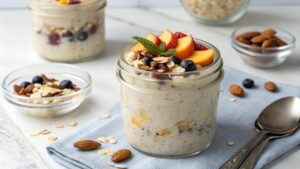
- 1/2 cup rolled oats
- 1/2 cup milk (or shelf-stable milk alternative)
- 1 tbsp chia seeds
- 1 tbsp maple syrup or honey
- Toppings of choice (dried fruits, nuts, cinnamon)
By morning, the oats have absorbed the liquid and created a delicious no-cook breakfast. This option eliminates morning prep entirely and works well for those days when you want to hit the trail early.
Lunch on the Go: Quick and Portable Options
Lunch during camping trips needs to be especially versatile – sometimes we’re back at the campsite, other times we’re out on a hike or at a nearby lake. Having options that work in different scenarios has been key to our camping success.
Wraps and Roll-Ups
Tortillas have become my camping MVP. They’re versatile, don’t crush like bread, and stay fresh longer. Some favorite combinations:
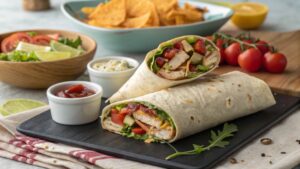
- Peanut butter and banana with a drizzle of honey
- Turkey, cheese, and thinly sliced apple
- Hummus with cucumber and carrot sticks
- Cream cheese with smoked salmon (for more adventurous kids)
I prep individual ingredients in separate containers, and the kids build their own wraps. This activity keeps them engaged and ensures each child gets exactly what they want.
Mason Jar Salads
For a more nutritious option that travels well, mason jar salads have been a game-changer. The key is layering:
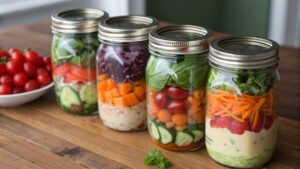
- Dressing at the bottom
- Hard vegetables like carrots or bell peppers
- Proteins like beans, tuna, or cubed chicken
- Softer items like cheese or avocado
- Greens at the very top
When it’s time to eat, just shake the jar and everything gets coated with dressing. My kids love the novelty of eating from a jar, and I love that they’re getting vegetables during our trip.
Trail Mix Builder
Setting up a “trail mix station” lets kids create their own hiking fuel. I bring small containers of:
- Nuts (almonds, cashews, peanuts)
- Seeds (sunflower, pumpkin)
- Dried fruits (raisins, cranberries, apple chips)
- Cereals (Cheerios, Chex)
- Sweet treats (chocolate chips, yogurt-covered raisins, mini marshmallows)
Each child gets a reusable snack bag and can create their perfect combination. This activity usually happens on our first evening, creating snacks that last throughout the trip.
Dinner Delights: Evening Meals to Remember

Dinner is where camping food magic happens. It’s when we gather around the fire, share stories from our day, and create those core camping memories. These meals need to satisfy hungry explorers while still being manageable to prepare with limited resources.
Foil Packet Dinners
Foil packet cooking has revolutionized our camp dinners. These customizable meals are cooked directly in the campfire coals or on a grill, with each family member getting their own personalized packet. The basic formula:

- Protein (ground beef, chicken pieces, fish fillets, sausage slices)
- Quick-cooking vegetables (zucchini, bell peppers, mushrooms, cherry tomatoes)
- Starch (thinly sliced potatoes, corn kernels, instant rice)
- Seasoning and a splash of liquid (chicken broth, olive oil, butter)
Each ingredient is thinly sliced or chopped to ensure even cooking. The packets are then sealed tightly, labeled with names using a permanent marker, and cooked in the coals for about 20-30 minutes, depending on contents.
My kids love opening their packets to discover dinner, and I love the zero-cleanup factor. Just be sure to bring heavy-duty foil – regular foil can tear easily, resulting in disappointment and wasted food.
One-Pot Pasta Wonders
A large pot and portable camp stove open up a world of one-pot meal possibilities. My kids’ favorite is a simple pasta dish where everything cooks together:
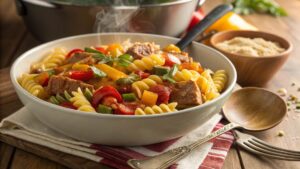
- Add 4 cups of water to a large pot
- Add 1 lb of pasta, 1 jar of pasta sauce, and 1 lb of sliced smoked sausage
- Bring to a boil, then simmer until pasta is tender (about 12 minutes)
- Stir in 1 cup shredded cheese until melted
The pasta absorbs the flavors as it cooks, creating a rich, satisfying meal with minimal effort and cleanup. You can easily adapt this with different proteins or vegetables based on your family’s preferences.
Campfire Pizzas
Individual pizzas cooked over the campfire turn dinner into an interactive experience. I bring:

- English muffins or pita bread for the base
- Small jar of pizza sauce
- Pre-shredded mozzarella
- Pepperoni or pre-cooked sausage crumbles
- Pre-chopped vegetables
Each child assembles their pizza on a piece of foil, then we place them on a grill grate over the fire. They cook quickly, about 5-7 minutes until the cheese is bubbly. My middle child, who normally picks every vegetable off his pizza at home, proudly adds mushrooms and bell peppers to his campfire creation!
Sweet Treats: Beyond Basic S’mores
No camping trip is complete without dessert around the campfire. While classic s’mores will always have their place, we’ve expanded our repertoire to include other sweet treats that kids can help prepare.
Campfire Cones
This s’more alternative has become our new favorite tradition. We bring:

- Ice cream cones (the pointy sugar cones work best)
- Mini marshmallows
- Chocolate chips
- Other fillings (banana slices, strawberries, peanut butter chips)
Kids fill their cones with their preferred ingredients, then we wrap them tightly in foil and place them near (not directly in) the campfire coals for about 5 minutes. The result is a gooey, melted treat eaten with a spoon right from the cone.
Dutch Oven Cobbler
For special camping occasions, I break out the Dutch oven for a simple cobbler:
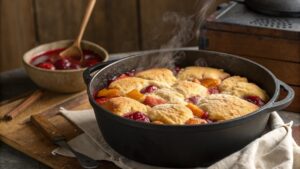
- Line the Dutch oven with foil for easier cleanup
- Pour in 2 cans of pie filling (peach and cherry are favorites)
- Top with a dry cake mix
- Drizzle with 1/2 cup melted butter
- Cover and place on coals, with additional coals on the lid
After about 30 minutes, we uncover a bubbling, cakey treat that serves the whole family. The combination of the outdoor setting and warm dessert makes this simple recipe taste gourmet.
Grilled Banana Boats
These are incredibly simple but always a hit:
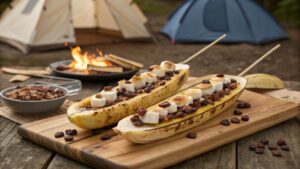
- Cut a slit lengthwise in an unpeeled banana
- Stuff with chocolate chips and mini marshmallows
- Wrap in foil and place on grill grate for 5-7 minutes
The heat makes the banana soft and sweet while melting the fillings inside. Eaten straight from the peel with a spoon, it’s a less messy alternative to s’mores that still delivers that crucial chocolate-marshmallow combination.
Comparing Cooking Methods: Finding What Works for Your Family
Over the years, I’ve tried various cooking methods at the campsite. Each has its advantages and challenges, especially when cooking with kids in tow. Here’s a breakdown of the main options:
| Cooking Method | Pros | Cons | Best For |
|---|---|---|---|
| Campfire | – Creates authentic camping experience – Provides ambient light and warmth – Kids love cooking over fire – Free fuel source |
– Weather dependent – Difficult to control temperature – Requires fire-building skills – Not allowed in all camping areas |
– Foil packets – Skewers – Dutch oven cooking – Marshmallows and s’mores |
| Camp Stove | – Consistent heat – Quick to set up – Works in most weather – Familiar cooking experience |
– Requires fuel – Limited cooking surfaces – Additional equipment to pack – Less “camping feel” |
– Pasta dishes – Breakfast scrambles – Hot beverages – Anything requiring simmering |
| Portable Grill | – Great for traditional grilled foods – Easy temperature control – Familiar flavors for kids |
– Bulky to transport – Requires charcoal or propane – Additional cleanup – Setup time |
– Burgers and hot dogs – Grilled vegetables – Quesadillas – Corn on the cob |
| No-Cook Options | – Zero setup time – Works in all weather – No fire restrictions concern – Often kid-friendly foods |
– Limited menu options – Less satisfying in cold weather – Misses camping cooking experience |
– Lunch on hiking days – Backup meals – Breakfasts on early start days – Snacks |
I’ve found that a combination approach works best for us. We use the campfire for dinner and special experiences, the camp stove for breakfast and backup cooking, and incorporate no-cook options for lunches and busy days. Consider your camping style, location restrictions, and your children’s ages when deciding which methods to emphasize.
Special Dietary Needs: Adapting for All Eaters
Camping with kids who have dietary restrictions requires extra planning, but is entirely manageable. My nephew has celiac disease, and my oldest recently decided to become a vegetarian, so I’ve learned to adapt our camping menu accordingly.
Gluten-Free Camping
For campers avoiding gluten:
- Corn tortillas work wonderfully for wraps and quesadillas
- Foil packet meals with meat and vegetables are naturally gluten-free
- Rice-based sides travel well
- Bring a dedicated cutting board and utensils to prevent cross-contamination
- Pack gluten-free graham crackers for s’mores
Vegetarian Options
Plant-based campers can enjoy:
- Bean and cheese burritos
- Foil packets with extra vegetables and tofu
- Vegetable skewers with halloumi cheese
- Pasta with marinara sauce
- Hummus and vegetable wraps
The key is ensuring vegetarian options are substantial enough to provide energy for active days. I focus on incorporating protein through beans, nuts, cheese, and plant-based protein sources.
Managing Food Safety in the Great Outdoors
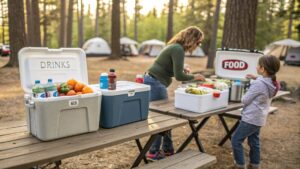
Food safety becomes even more critical when camping, especially with children whose immune systems may be more vulnerable. Over the years, I’ve developed a system that keeps our food safe without requiring excessive cooler space.
Cooler Strategy
I use a two-cooler system:
- Drink Cooler: Opened frequently throughout the day
- Food Cooler: Opened only during meal prep
This keeps perishable food colder longer. I pack the food cooler strategically:
- Frozen meat at the bottom (doubles as ice packs)
- Dairy products in the middle
- Fruits and vegetables on top
- Pre-frozen water bottles as additional ice
I also prepare foods that can be used early in the trip if they require refrigeration, saving shelf-stable options for later days.
Hand Hygiene
With kids, maintaining hand cleanliness before food prep is challenging but essential. My camping kitchen always includes:
- Portable hand washing station (water jug with spigot, soap, paper towels)
- Alcohol-based hand sanitizer at the ready
- Antibacterial wipes for quick cleanup
I’ve turned handwashing into a pre-meal routine that’s non-negotiable, framing it as part of our special “camping kitchen rules.”
Budget-Friendly Camping Meals
Camping doesn’t have to break the bank. Some of our most successful and memorable meals have been the simplest and most economical.
Affordable Crowd-Pleasers
These budget-friendly options have become staples in our camping meal rotation:
- Walking Tacos: Individual bags of corn chips topped with pre-cooked taco meat from home (kept frozen until use), shredded cheese, and toppings. Eaten directly from the bag with a fork – no plates needed!
- Instant Oatmeal Bar: Basic instant oatmeal packets with an array of toppings (dried fruit, brown sugar, nuts). Extremely economical and customizable.
- Hobo Stew: Ground beef, potatoes, carrots, and onions in foil packets. Simple ingredients create a hearty meal.
I’ve found that casserole-style one-pot meals generally stretch ingredients further and create less waste than individually portioned meals. They’re also usually more budget-friendly and simpler to prepare.
Equipment Essentials: What You Actually Need
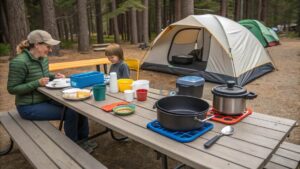
When I first started camping with kids, I overpacked cooking equipment, making meal prep more complicated than necessary. Through experience, I’ve pared down to the essentials that make cooking enjoyable without overwhelming our packing space.
My Must-Have Cooking Tools
- Cast iron skillet (versatile for breakfast, lunch, and dinner)
- Medium pot with lid (for pasta, oatmeal, soup)
- Collapsible water container
- Sharp knife and small cutting board
- Long-handled tongs and spatula
- Aluminum foil (heavy-duty)
- Biodegradable plate set and utensils
- Dish washing bin and biodegradable soap
For family camping, I’ve found that one cooking surface per active meal preparer is a good rule of thumb. My partner and I can efficiently prepare a meal with a skillet and pot without feeling cramped or overwhelmed.
Splurge-Worthy Additions
If you camp regularly with kids, a few strategic investments can significantly improve the experience:
- Dutch oven: Opens up a world of baking and one-pot meal options
- Portable coffee maker: Makes mornings dramatically more pleasant for adults
- Quality cooler: Keeps food safely cold longer, reducing ice runs and food waste
Kid-Friendly Food Activities
Involving children in meal preparation creates ownership and enthusiasm around camping meals. These activities keep kids engaged while teaching outdoor skills:
Orange Cup Muffins
This recipe doubles as a cooking project:

- Cut oranges in half and scoop out the fruit (eat as a snack)
- Fill orange peels halfway with pre-made muffin batter
- Wrap in foil and place on campfire coals for 10-15 minutes
Kids are fascinated by the orange-infused muffins that emerge. The activity occupies about 30 minutes from start to finish – perfect for that transitional time before dinner.
Stick Bread

Simple bread dough (store-bought or homemade) is wrapped around sticks and roasted over the campfire. Children practice patience as they slowly rotate their sticks to achieve even cooking. The result is a warm, hollow bread tube that can be filled with jam, honey, or chocolate spread.
Scavenger Hunt Salad
For older kids, create a list of edible natural items to find around the campsite (with clear safety guidelines about what’s safe to eat). Examples might include:

- Wild berries (only specific, easily identifiable ones)
- Dandelion leaves
- Wild mint
Combined with packed ingredients, these foraged items create a special salad with a story. This activity works best in areas where you’re confident in plant identification and foraging is permitted.
Environmental Considerations: Leave No Trace Cooking
Teaching children to respect nature while cooking outdoors is an essential part of the camping experience. Over the years, I’ve incorporated Leave No Trace principles into our camp cooking routines:
Minimizing Campfire Impact
We:
- Use established fire rings only
- Keep fires small and manageable
- Burn only clean wood, never trash
- Fully extinguish fires
I teach my kids that whatever we bring to the campsite must leave with us, including food scraps, packaging, and cooking water.
Reducing Packaging Waste
Pre-trip meal preparation significantly reduces packaging waste at the campsite. I:
- Transfer foods to reusable containers before leaving home
- Use beeswax wraps instead of plastic wrap
- Pack ingredients in precise amounts needed
- Bring cloth napkins instead of paper
Managing Food Waste
Proper food waste disposal is crucial for wildlife protection:
- Pack out all food scraps
- Use mesh strainers when washing dishes to catch food particles
- Never pour cooking oil or grease on the ground
- Store all food securely to prevent wildlife access
These practices have become automatic for my kids, who now remind ME if I accidentally drop a food wrapper!
Seasonal Considerations: Adapting Throughout the Year
Our family camps in different seasons, and I’ve learned that meal planning needs to adjust accordingly.
Summer Camping Meals
In hot weather, we focus on:
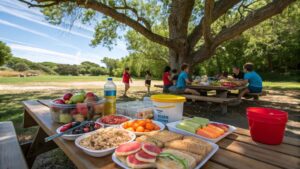
- Cold breakfast options (overnight oats, fruit, granola)
- No-cook lunches to avoid adding heat
- Lighter dinner options cooked quickly
- Foods that don’t spoil easily
- Extra hydration options like fruit-infused water
Fall and Spring Camping
Shoulder seasons call for:
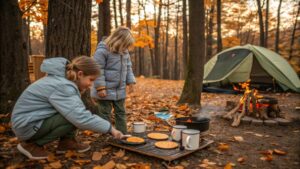
- Warming breakfast options like oatmeal and pancakes
- Heartier one-pot dinners
- Hot chocolate and warm cider for evenings
- Foods that provide sustained energy in variable temperatures
Winter Camping
Though more challenging with kids, winter camping requires:
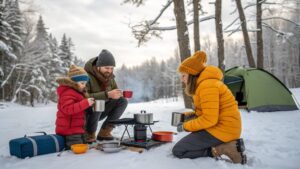
- High-calorie, warming meals
- Thermos cooking for some items
- Hot drinks available throughout the day
- Simple recipes that can be prepared while wearing gloves
Lessons Learned: My Biggest Camping Food Mistakes
Through years of family camping, I’ve made plenty of meal mistakes. Sharing them might save you some headaches:
Mistake No. 1: Overly Ambitious Menus
Early on, I tried to replicate elaborate home-cooked meals at the campsite, leading to stress and disappointment. Now I embrace simpler options that allow more family time and less cooking time.
Mistake No. 2: Inadequate Food Storage
A raccoon incident during our second family camping trip taught us the importance of proper food storage. Now we use sealed containers and vehicle storage when appropriate, never leaving food accessible.
Mistake No. 3: Not Having Backup Plans
Weather changes, forgotten ingredients, and equipment failures happen. I now always pack shelf-stable backup meals that require minimal preparation – instant soup, pasta with sauce, or even quality freeze-dried camping meals.
Mistake No. 4: Ignoring Time Constraints
I once planned meals requiring 45+ minutes of preparation after arriving at our campsite at dusk. Now I ensure first-night meals are essentially ready to heat, saving more involved cooking for days when we have ample daylight and energy.
Putting It All Together: Sample 3-Day Meal Plan
Here’s a realistic meal plan for a weekend camping trip with kids that incorporates many of the principles I’ve discussed:

Day 1
Arrival Dinner:
- Pre-made foil packet meals (prepared at home, transported in cooler)
- Garlic bread (store-bought, wrapped in foil and heated on grill)
- Campfire cones for dessert
This meal requires minimal prep after arrival, perfect for setting up camp.
Day 2
Breakfast:
- Pancakes with toppings bar
- Pre-cooked bacon (reheated in skillet)
- Fruit
- Coffee/hot chocolate
Lunch:
- Build-your-own wraps
- Chips
- Apples and peanut butter
Dinner:
- Campfire pizzas
- Dutch oven cobbler
This day balances easy preparation with fun, interactive meals.
Day 3
Breakfast:
- Overnight oats (prepared the night before)
- Bananas
- Coffee/hot chocolate
Lunch:
- Packing up meal: remaining sandwich ingredients, fruit, and snacks
The final day features quick options to facilitate timely departure.
Final Thoughts:
After years of refining our approach to camp cooking, I’ve realized there’s no one-size-fits-all solution. Some families thrive on elaborate outdoor cooking as a central activity, while others prefer simplicity to maximize exploration time.
What matters most is finding the balance that works for your unique family. Camping meals should be enjoyable for everyone – including the adults preparing them. Start simple, adjust based on experience, and remember that pizza cooked over a campfire somehow always tastes better than delivery, even if it’s slightly burnt on the edges.
The food memories your children will cherish likely won’t be about culinary perfection but rather the experience of eating together under the stars, making s’mores with sticky fingers, and learning that food prepared outdoors has a special magic all its own.
Happy camping and happy eating!
What are your family’s favorite camping meals? Share your tips and recipes in the comments section below!
Additional Resources
- Minimalist Camp Kitchen Setup: This will help you create a more efficient outdoor cooking system.
- How to Make Dehydrated Camping Meals: Learn how to pack food that is lightweight, doesn’t spoil and tastes good.
- The Ultimate Guide to Long-Term Camping Food Storage: Learn proven methods, essential gear, and expert strategies to keep your food fresh, safe, and accessible.
- The Ultimate Guide to Dutch Oven Cooking While Camping: Learn about off-grid camp cooking and recipes.
- Easy One-Pot Off-Grid Camping Meals for Outdoor Adventures: Learn my absolute favorite one-pot wonders that will fuel your wilderness adventures.
- Fireless Cooking Methods: Learn essential fireless cooking methods for remote camping
- Wilderness Cooking Techniques: Learn the best cooking techniques in the wilderness that will give you the best outdoor meal experience.
- 10 Campfire Recipes That Won’t Bomb: Check out this curated list of campfire recipes that keep you going off-grid during camping
- Ultimate Guide to Wilderness Survival Skills: Talks comprehensively about survival skills in the wild or off-grid.
- How to Stay Safe While Camping Off-Grid: Offers safety and survival tips in the wilderness
1. How do I keep food cold while camping without electricity?
Good cooler management is key! I use a two-cooler system – one for drinks (opened frequently) and another for food (opened only during meal prep). Pre-freeze meats and meals to act as additional ice packs.
Pack your cooler strategically with frozen items at the bottom, dairy in the middle, and produce on top. Replace ice as needed and keep coolers in shade or cover with a reflective blanket.
For longer trips, plan meals that use perishable ingredients first, saving shelf-stable options for later days.
2. What are the best camping meals for extremely picky eaters?
I’ve found that familiar favorites with small camping twists work best. Build-your-own meal stations (tacos, pizzas, wraps) allow picky eaters to choose only what they like.
Comforting basics like mac and cheese can be elevated with foil packet cooking methods. Always pack reliable backup options your picky eater will definitely consume – for my youngest, that’s peanut butter tortillas and string cheese.
Most importantly, camping often makes kids more adventurous eaters – I’ve seen my pickiest child try new foods simply because of the novelty of outdoor dining!
3. How can I handle dishes and cleanup with minimal water?
This was one of my biggest challenges! Start by using as few dishes as possible – foil packet meals and one-pot dinners significantly reduce cleanup. Bring biodegradable plates and utensils for really messy meals.
For washing, I set up a three-basin system: one with soapy water, one with clean rinse water, and one with sanitizing solution (1 tablespoon bleach per gallon of water). Use a mesh strainer to catch food particles before disposing of gray water according to campground regulations.
Pre-cleaning dishes with paper towels reduces water needed for washing.
4. What are some no-cook camping breakfast ideas for early mornings?
For those dawn departure days, I rely on overnight oats prepared the evening before, bagels with cream cheese and fruit, yogurt parfaits with granola and berries, or make-ahead breakfast cookies packed with oats, dried fruit, and nuts.
Shelf-stable milk boxes or plant-based milk alternatives don’t require refrigeration until opened. Cold brew coffee prepared the night before is also a lifesaver for adults needing caffeine before early hikes!
5. How do I plan camping meals for a large family or multiple families camping together?
Group camping requires extra coordination, but can actually be more efficient! I recommend assigning each family one dinner responsibility during the trip while handling your own family’s breakfasts and lunches.
For shared meals, one-pot options that scale easily work best – think chili, pasta dishes, or taco bars. Communal Dutch oven cooking is perfect for feeding crowds. Create a shared shopping list with clear assignments to avoid duplicates and unnecessary waste.
Consider a central “pantry” area with staples everyone can access like condiments, spices, and cooking oils.

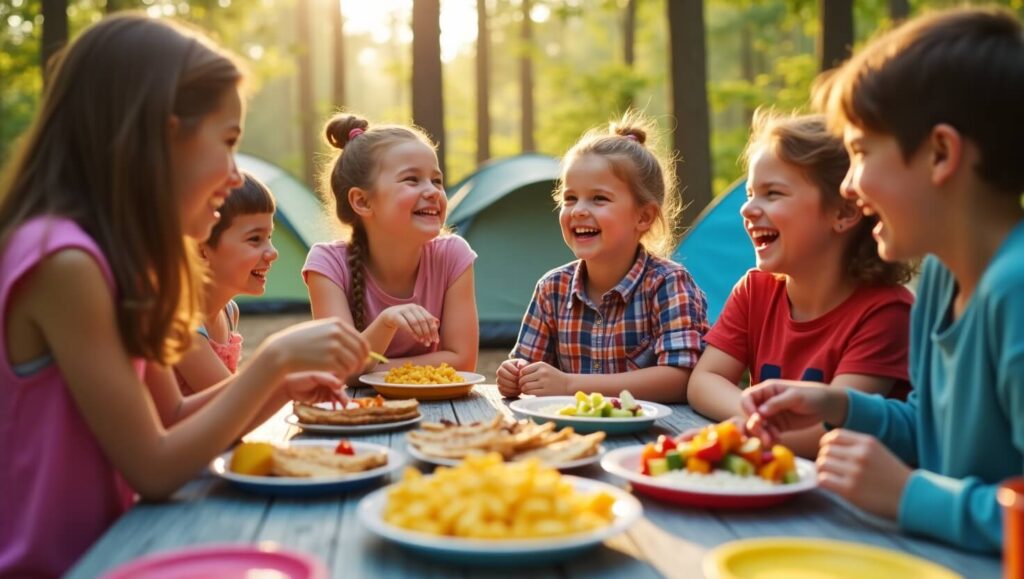
Very good https://shorturl.at/2breu